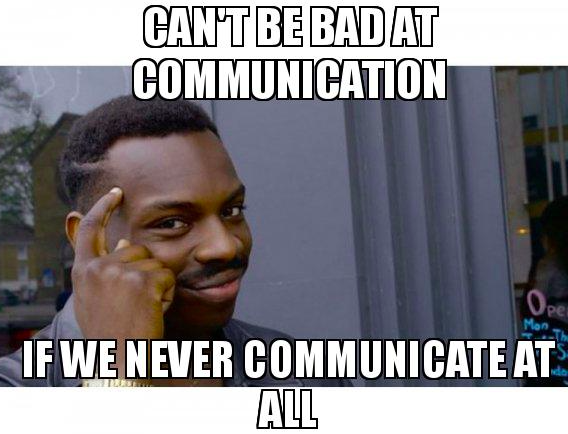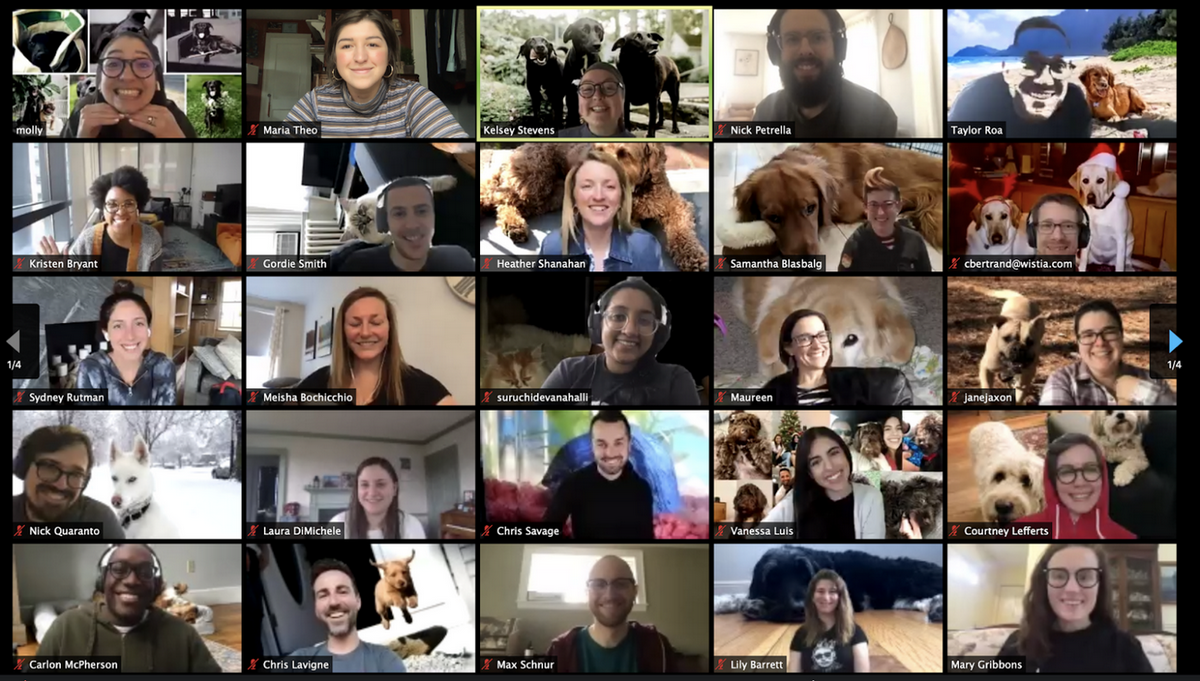At first glance, communication is easy and you don’t even need a strategy to communicate. You just have to say something on topic, listen to other people and respond accordingly. But when it comes to communication in remote teams, it doesn’t work in such a simple way. If you want your distributed team to communicate effectively, you need a communication strategy and this article will help you develop it right.
What is a communication strategy at all?

According to Oxford Dictionary, a strategy is “the process of planning something or putting a plan into operation in a skilful way”. A communication strategy, accordingly, is a set of pre-developed rules and practices that allow a group of people to communicate effectively and achieve their goals.
But that’s easier said than done, especially when you have a distributed and international team and have to work out time zones. And even though remote teams are pretty effective when managed right, there are still some communication challenges you should be aware of when developing your remote team communication strategy.
Common communication challenges your remote team likely faces
Regardless of the project size, team location and communication methods, most remote teams face the same challenges.
- Technical issues. Modern devices and communication tools have evolved significantly in response to the rise in remote work. However, sometimes avoiding noise and other technical issues becomes difficult or almost impossible, which leads to communication delays and interruptions.
- Management challenges. The way of managing teams working remotely is also decisive for effective online communication. Having too many or too few online meetings leads to either work time waste or inability to effectively communicate on the most important tasks.
- Personal challenges. From a personal perspective, communication in remote teams doesn’t differ much from face-to-face one. However, remote team members may have language barriers and cultural differences. The skill to accept someone’s opinion, recognize their own mistakes, and listen (and most importantly, hear other team members) are also essential for making remote team communication effective.
How to develop an effective communication strategy for a remote team
So, how to improve communication with remote workers? Follow the next list of practices for making remote team communication effective and developing a clear communication strategy.
Align the time zones
The first step towards effective communication in a remote team is giving them the actual opportunity to talk to each other. Get started by aligning the time zones in such a way that all team members have at least two business hours overlap.
There is also an inspiring example of Zapier – the company with more than 300 remote employees distributed across the globe. They recommend team members learn the main time zones to quickly navigate them, use instant messengers to see who is online now and plan team meetings in advance, considering the time zone and availability of the invited team members.
Choose the right tools
There are many remote team communication and collaboration tools, and that’s why making the right choice can be challenging. Here’s what you can do.
- Choose a collaboration tool depending on your project specifics. For example, small and predictable projects created according to the Waterfall methodology can easily be handled with the help of Trello, BaseCamp, Breeze or Asana. Medium to large projects with several distributed teams behind are better to choose Jira, Monday, or ClickUp.
- Choose dedicated communication tools for texting and video calling, for personal and work-related communication. For example, you can use Zoom or Google Meet for video conferencing, Slack for work-related communication in dedicated channels, and Telegram for personal chatting and meme sharing.
- Let your team choose a personal communication tool on their own. While the choice of work-related apps is always project-dependent, your team will appreciate the opportunity to choose the tool for personal and easy-going communication. Run an opinion poll to find the tool your team will be happy with.
- Don’t switch communication channels for no reason. While most communication apps are pretty easy to use, switching to another one can be annoying and even stressful for team members who got used to a certain app. So, don’t change communication tools unless it is a crucial necessity for your project.
Have a remote communication culture
Despite a distributed team working from home or any other location, having a remote communication culture is still essential. For the major part, it doesn’t differ much from personal communication in the office. However, sometimes a remote team meeting looks like this.

While we aren’t going to blame cats and dogs, such a messy environment is a source of additional noise. Moreover, it doesn’t contribute to effective communication because of multiple distractions. That’s why it is better to have a clear and strict remote communication policy, requiring your remote team members to be a little more formal during video meetings. At the same time, do encourage video communication – it is as close to face-to-face one as possible, allowing for making personal connections and understanding each other better.
P.S. Bring Your Pet Day is a great idea for remote team building but it shouldn’t be an everyday practice.
Develop communication rules and practices
Clear communication rules and practices are at the heart of any remote team communication strategy. Below are the life-proven ones.
- Set a strict response time. Usually, it is around 20 minutes for notifications in instant messengers, and up to 3 hours for email communication. However, keep the essence of asynchronous communication in mind when setting the response times. The necessity to distract from the task and respond to a message decreases productivity.
- Use tags. For example, suggest your team members use an “Action Required” notification in an urgent email header. Also, develop a practice of tagging teammates in a task manager to ensure a seamless workflow and update their work statuses accordingly.
For example, Groove intentionally hires people who respond quickly, validating this personal trait or habit from the very beginning of the hiring process. They also practice daily check-ins in an instant messenger to keep the team accountable and let team members easily document their daily tasks in a less formal way.
Don’t skip employee onboarding
Onboarding your new employees is a must for their success in a new workplace and communication with teammates. So, after you have developed a remote communication policy, prepare a clear and well-structured document you can introduce to new team members.
Also, introduce new team members to tools you are using for collaboration and communication, dwell on the standards the team follows and encourage your current employees to support new ones.
Schedule online meetings when they are really necessarily
Having too many or no online meetings at all can be equally counterproductive for your team. Follow the next tips when balancing between online meetings, texting and emailing.
- Avoid the “it should be an email” situation. Instead, schedule online meetings only when you have to brainstorm new ideas or make a collective decision.
- Schedule daily/weekly meetings keeping time zones in mind, and use this time to discuss daily/weekly plans. Careful planning and an in-advance discussion will allow for reducing the number of online meetings during the week, or at least, transform them into short calls. Also, it is better to plan daily and weekly meetings in the first half of the workday if possible when most employees are more focused than at the end.
Never skip the context
Context matters for effective online communication. That’s why you should always start a meeting by explaining the team why they are here, especially if there are new team members on board, and ask other team members to do the same during online conferences. Such a simple practice will allow you to avoid misunderstandings, mistakes and additional clarifications later on.
Explaining the context is especially important for augmented teams. While in-house team members are usually better versed in an issue, augmented ones have no physical opportunity to get on the same page instantly.
Run an internal newsletter
Running an internal newsletter is another practice to keep your remote team updated and at the same time, decrease the number of online meetings. What’s more, your internal newsletter shouldn’t be official – sharing weekly news and events in a dedicated Slack or Telegram channel can be enough.
Stay connected with the team
Like remote communication, remote leadership is also somewhat specific. In the case of managing a remote team, leadership and ordinary team members should stay in even closer touch than when working in an office together. Frequent communication between executives and team members is essential for supporting team spirit, promoting the feeling of belonging and making your team members feel appreciated.
Launching bi-weekly virtual town halls with a team is a great way to stay connected to them and make sure leadership and team members are in sync. During the town hall, the team can talk to the CEO and leadership directly, learn the important news firsthand, and ask questions.
Ask your team members for feedback
The great remote communication strategy is the one that helps with achieving project and business goals. However, it will work right only when your employees are happy with it. That’s why asking them for feedback is essential for either making sure that your communication practices work well for the team, or for revising the strategy and making it more effective, keeping the team’s expectations in mind.
Running a survey in Google Forms is the easiest option to let your employees share their feedback, highlight communication gaps and suggest better ideas.
The most important piece of advice – hire candidates with successful remote work experience
So, now you are welcome to develop a great communication strategy for your remote team, but keep one more important thing in mind. Even when your communication strategy is excellent and you are skilled with remote team management, it is still better to hire employees experienced with working as a part of a distributed team. In such a case, onboarding them and ensuring their productive collaboration with other team members will be significantly easier.
However, is there a solution if your great candidate is the one with no remote work experience? Undoubtedly, you shouldn’t skip them and look for another one. Instead, pay double attention to their personal qualities such as an ability to meet deadlines, responsibility and communication skills. For example, TopTal intentionally looks at and prioritizes remote-friendly personal traits during the hiring process, evaluating the ways a person responds in instant messengers, acts during video calls and even their sense of humor.
As for another solution to hire the best-match candidates with both remote work experience and the necessary skill set, consider our sourcing-as-a-service. With the help of our advanced hiring technology, we can quickly select suitable candidates using multiple filters and choosing from a huge still structured data pool.
Our hiring process is 80% automated, allowing us to find the finest-tuned candidates five times faster and 60% cheaper compared to looking for them on your own or with the help of a no-tech-enabled recruitment agency. What’s more, the majority of our candidates use our sourcing-as-a-service to build distributed teams from scratch, ensuring the perfect skill set match and cultural fit.
Get started with more effective remote hiring today. Contact us to try our sourcing-as-a-service in action and build a thriving remote team!



